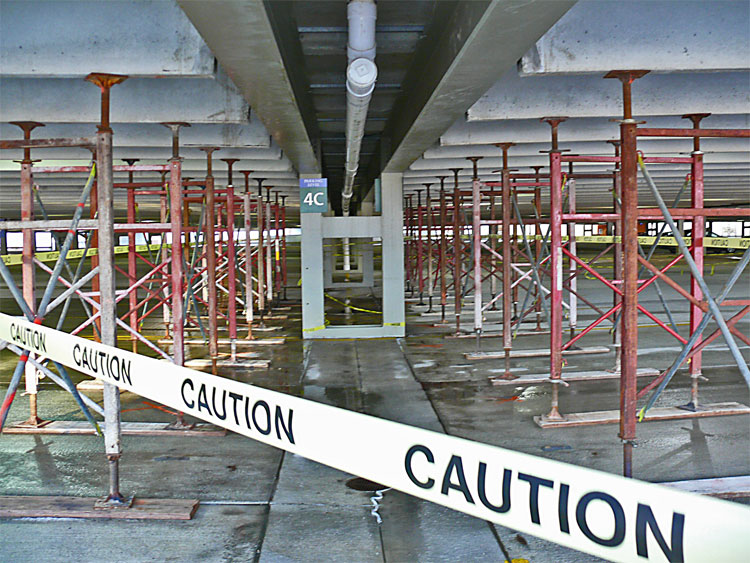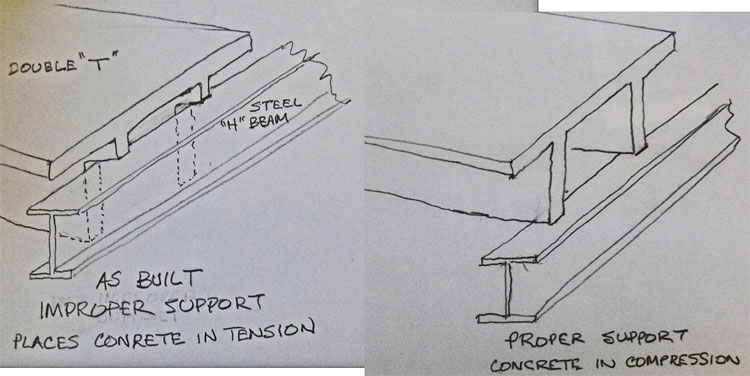
University Square was described in this 2003 [1] International Council of Shopping Centers.
Two weeks ago I visited the mall and drove up to the top floor (5th) of the mall’s parking structure. There is a stop sign on the entry ramp at the 4rd floor, and when I looked right, into the 4rd floor, I was surprised to see a section of shoring set up under the end of one of the double T beams (the upper surface of the double T beams comprised the 5th floor parking deck). I walked in and did my shopping and then had to leave in a hurry to make an appointment. No time to investigate.
The parking structure’s steel vertical supports seemed inordinately airy and light weight as far as parking decks go.
As I was driving away I thought a little more about the shoring and my mind went to the failure details of the Kansas City Hyatt Regency walkway collapse [2] which killed 118 people in 1981.
In the meantime the Dirty Dealer scooped me and published an unintelligible report on the problems at the parking garage. Yesterday I visited the parking structure again when I went to Macy’s.
It’s in bad shape

The double “T” beams have at least 3 serious very serious design issues.
1. The ends of the Ts are notched much too deeply, putting almost all the load into the top cord of the T, and almost none of the load into the vertical leg of the T. You can see this same type of failure in the images of this pdf [3] . Open the pdf and go to the last half of the pdf to see a study of images of similar failed double T beams published in 2005.
2. The lateral edges of the arms of the “T”s are not connected (as many concrete floor planks are) with any type of tongue and grove or other positive beam edge to beam edge connection. This is one of the reasons behind the failure of the top chords of the T beams on the ramps. And the same failure is evident on the top deck of the parking structure.
3. Constant deck flexure under automobile traffic loading is exacerbating each of the first 2 problems.
The present “stabilization” using shoring frames has the Kansas City Hyatt problem:
The Kansas City collapse (linked to Wikipedia above) was caused by hanging twice the correct design weight on nuts supporting the walkway bridges. This was done inadvertently when the original engineering plans were not carried out correctly during construction. Take a look at the Wikipedia explanation and diagram showing how the support rods went through the deck supports.
The University Square parking structure is making the exact same type of mistake made at the Hyatt in 1981. In the parking structure shoring frames have been placed under many of the T beams which have visible failure cracks at their ends. The shoring frames are intended as protection should the T beam above them fail and drop. Perhaps the shoring frames were also “loaded” (cranked up so they are actually taking some or all of the weight of the upper T) when they were installed. Loaded or unloaded, the shoring frames are using the T beam below them for support. Thus the lower T beam (and the structural steel on which the T beam rests) now has more load on it than it was originally designed to handle. Very likely twice the load the flange of the lower T beam was designed to carry.
For the shoring to be done properly, any floor on which a shoring frame is placed should have shoring directly underneath every frame on each floor of the structure all the way down to the ground (assuming the earth has the bearing capacity to support the anticipated failure load – which it probably doesn’t). With one shoring frame above the other, the loads are taken to the ground without going into other T beams or into the structural steel.
A further serious problem I noticed was that in some areas of the garage (4th floor near the ramp), there are visibly cracked T beams without any shoring frames under them.
And, of course, the worst thing you can do to a reinforced concrete structure (especially one which has failure cracks to admit the moisture) is let rainwater and salt (brought in by the cars) shower down through the entire parking structure. That’s what is happening at the University Square parking structure because of sloppily designed roof scuppers and gutters. Instead of getting the precipitation into pipes, the water is allowed to drip and pour down floor by floor. It sounded like being in the shower when I was there.
So, what to do?
First I would like to see if a state licensed engineer has stamped the shoring design. Does the shoring design show the load paths under the shoring frames? If there is no state licensed engineer overseeing the temporary support system, the situation is clearly in violation of common sense and the building codes.
Next I would like to see a document stamped by a state licensed engineer who has carried out structural analysis on the cracked T beams confirming that the un-shored cracked T beams are sufficiently sound.
I believe – if only because of the lack of consistency between some cracked T beams being shored and other similarly cracked T beams being un-shored - that for public safety the parking structure should be closed immediately.
-----------------------------------------------
The T beams were notched in the manner they were in order to place as many floors as possible into the overall parking structure’s height. In the isometric sketch below the left hand drawing shows how the T beams are notched to so that they sit down “inside” the vertical dimension of the steel H beams. This system cuts down each floor to floor height by about 2+ feet (the same dimension as the notch in the end of the T beam). The right hand drawing shows the proper support method for a pre-tensioned concrete beam, but the downside is that the each floor to floor distance is greater. For example, if a 2 foot reduction in floor to floor height is gained over five floors, that means that the parking structure can have 5 decks in the same overall height as the proper design would allow 4 decks.

When the Cleveland Cuyahoga County Port Authority loaned the developer 40 million dollars for this garage, did the Port hire an engineer to review this stupid failure prone design? Isn’t the structure part of the collateral for the Port backed bonds? What good is this parking structure as collateral? It is a liability, not an asset.
Myers University, was also loaned about 6 million by the Port Authority. What is the Port’s collateral with Myers?
It is interesting that Starwood Wasserman was the developer of University Square [4]
and that Wasserman is also a partner with Vornado [5], the company behind the Chris Kennedy Merchandize Mart and other mart properties. Vornado is the company that Mr. Kennedy bragged about being worth billions when Mr. Kennedy gave the dog and pony show about the Cleveland Medical Mart last summer in the auditorium in the basement of the Cleveland Public Library.
This Vornado Starwood connection – and the Port Authority/County involvement with both, is another story isn’t it?
| Attachment | Size |
|---|---|
| Universitiy-Square-parking-.jpg [6] | 146.01 KB |
| Universitiy-Square-cracks-p.jpg [7] | 114.98 KB |
| Universitiy-Square-sketch-p.jpg [8] | 56.48 KB |